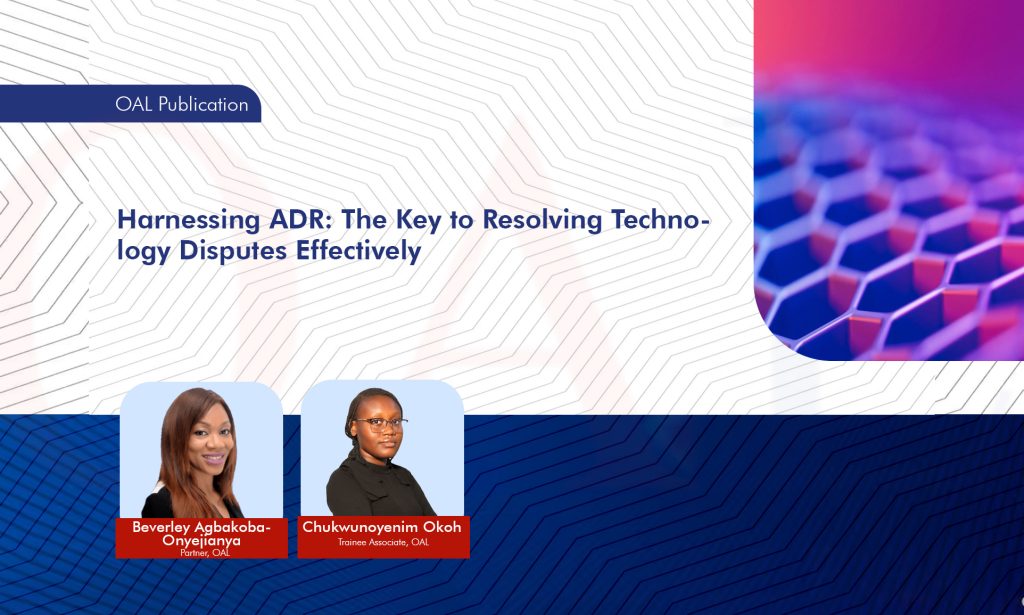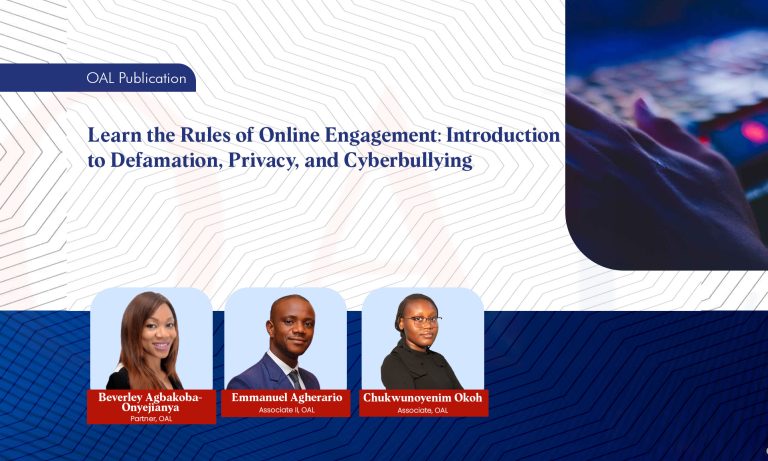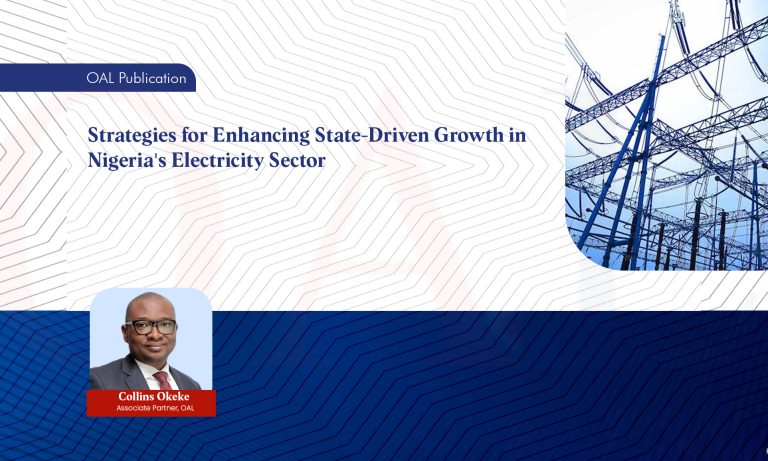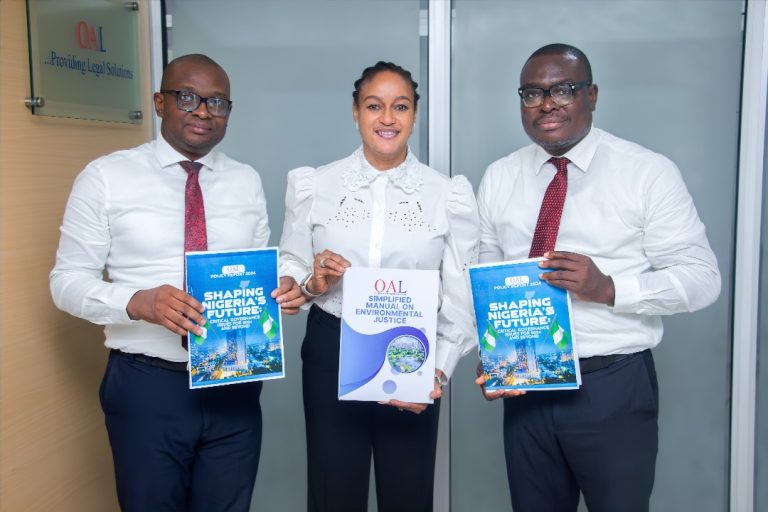-
Introduction
The external environment is in a constant state of flux with constantly changing regulations, accelerating speed of technological development, uncertainties in the socio-political climate and the introduction of smart working which has blurred the lines between our professional and personal lives.
The legal sector is equally not spared, as traditional legal theories and regulatory frameworks are being stretched and tested to new limits by the proliferation and impact of the fourth digital revolution.
Despite these multiple paradigm shifts, most especially due to Covid 19, access to justice is yet to adjust and catch up with changes in many countries all over the world, including countries such as Nigeria. In contrast, countries such as the United Arab Emirates (UAE) and Kenya have embraced the use of technology for resolving disputes notably Online dispute resolution (ODR) mechanisms. Adoption of ODR has been implemented by global e-commerce giants such as PayPal and Amazon whose internal online complaints management systems have facilitated settlements given the volume of sales activity.
The aim of this article is to expatiate ways arbitration and mediation can offer creative solutions to problems arising from digital change. We shall start by evaluating the benefits of alternative dispute resolution (ADR) over traditional litigation and its adaptability to the ever-evolving world of technology.
2. Why Should Technology Companies Embrace ADR?
As technology continues to advance, disputes concerning technology have experienced notable transformations and increased prevalence. These disputes often emerge in various areas such as intellectual property, software development, software audit, data licensing, collaboration risks, data breaches, trade secrets, and contractual disagreements concerning technology-based products or services.
The constant evolution of technology exposes the shortcomings of continued reliance on litigation in resolving disputes of this nature. Long timeframes for securing judgements, loss of confidentiality in court procedures, and judges who frequently lack the expertise to comprehend and settle issues using new technologies are among the disadvantages of this system.
Considering the aforementioned challenges, alternative dispute resolution (ADR) has become a better suited option for resolving technology-related disputes. ADR offers several advantages over litigation, which are outlined below:
a. Confidentiality:
Confidentiality plays a crucial role in alternative dispute resolution (ADR) methods such as mediation and arbitration, and its importance is amplified in technological disputes, which frequently encompass sensitive data, trade secrets, or proprietary technology. These ADR methods provide a secure environment where parties can openly address their concerns and engage in discussions without the worry of their private information being disclosed to the public. This confidentiality assurance fosters an atmosphere of trust and encourages parties to freely communicate, ensuring the protection of valuable intellectual property and enabling a more effective resolution of technological disputes.
b. Expertise:
ADR allows parties to select arbitrators or mediators who possess specialised expertise and experience in the specific technological field relevant to their dispute. This enables more informed decision-making during the resolution process. The chosen neutral professionals have a deep understanding of the technical intricacies involved, ensuring a comprehensive evaluation of the dispute and facilitating fair judgements or negotiations.
Furthermore, certain international organisations have established ADR centres to facilitate alternative dispute resolution. For example, the WIPO Arbitration and Mediation Centre and the Silicon Valley Arbitration & Mediation Centre serve as platforms for resolving technology-related disputes. These centres recognise the importance of specialised knowledge in addressing technological conflicts and provide a framework for effective ADR in the field.
c. Time and Cost Efficiency:
Traditional litigation is often characterised by lengthy, costly, and time-consuming processes. ADR proves to be a more cost-effective alternative compared to litigation. A case in point is the patent dispute between Apple and Samsung involving numerous lawsuits across 12 countries related to their smartphones. However, acknowledging the substantial expenses and time associated with litigation, both parties mutually decided to dismiss all non-US cases voluntarily. It is worth noting that both parties had expended more financial resources on litigations than on research and development efforts. Also noteworthy is the expert opinion of a former justice of the supreme court in the case of IPCO vs NNPC [2015] EWCA Civ 1144, where he affirmed that disputes in Nigerian courts could take up to three decades to resolve.
Alternative dispute resolution (ADR) methods are very business-friendly; they offer expedited and cost-effective resolutions. For instance, there is Expedited Mediation, potentially reducing the overall time and expenses involved in the dispute. Another example is Expedited Arbitration, which enables a swift arbitration process under the WIPO Expedited Arbitration Rules. By choosing ADR, parties can attain quicker and more efficient outcomes, avoiding the burdensome delays and financial implications typically associated with traditional litigation in complex technological cases.
d. Flexibility and Customisation:
ADR procedures can be customised to suit the distinctive demands of technological disputes, offering the parties greater flexibility and control over the process. This includes the ability to choose a neutral venue, define the scope of the dispute, and even determine the technical expertise desired in the arbitrator or mediator. By tailoring the ADR procedures to their specific needs, the parties can optimise the resolution process, ensuring that it aligns with the complexities and intricacies of the technological issues at hand. Such tailored ADR procedures empower the parties to shape the proceedings in a manner that best suits their unique circumstances and fosters a more effective and satisfactory resolution.
e. Preserving Business Relationships:
Disputes of a technological nature can arise amongst various stakeholders, including business partners, clients, or vendors. In such cases, ADR methods prioritise the pursuit of mutually acceptable solutions, enabling the parties to preserve their relationships and potentially continue their collaboration even after the dispute is resolved. By emphasising cooperation and understanding, ADR processes facilitate the restoration of trust and communication, fostering an environment where parties can find common ground and reach agreements that not only address the dispute at hand but also lay the foundation for continued positive interactions and future collaborations.
f. Flexible Awards/ Remedy:
Unlike traditional litigation, where the conclusion is frequently confined to monetary damages or a win/lose situation, alternative dispute resolution (ADR) procedures allow for more creative and customised solutions. Parties can pursue remedies other than monetary compensation, such as specific performance, injunctions, or licensing agreements. This adaptability allows disagreements to be resolved in a way that meets the specific requirements and interests of the parties involved, generating a sense of fairness and contentment with the conclusion. Furthermore, the collaborative character of ADR allows parties to maintain connections and pursue mutually beneficial agreements, which may not be achievable in a win-lose scenario of litigation.
3. Further Advantages of ADR Under the Arbitration and Mediation Act 2023
The enactment of the Arbitration and Mediation Act 2023 establishes arbitration and mediation as the favoured methods for resolving technology disputes instead of litigation. This new legislation recognises the impact of emerging technological advancements on ADR and as such makes notable amendments to the erstwhile Arbitration and Conciliation Act. The novelty of the new Act will be thoroughly discussed under this subheading.
a. Arbitration
i. Acknowledgement of E-Communication as a Type of Arbitration Agreement:
Traditional methods of communication are gradually being supplanted by electronic ones as a result of the rapid advancement of technology. The new Arbitration and Mediation Act 2023(The Act) unequivocally recognises and embraces email correspondence and similar electronic mediums, as a valid means of forming a legally binding arbitration agreement under Nigerian law.
Section 2(4) of the Act provides that if electronic communication is accessible for future reference, it fulfils the requirement for a written arbitration agreement. This provision brings clarity and certainty to technology disputes by acknowledging electronic communication, including data messages transmitted through electronic means like email and other messaging platforms.
By contrast, the previous Arbitration and Conciliation Act (ACA) vaguely mentions “other means of communication” without explicitly including electronic communication. By embracing electronic communication, arbitration provides a reliable and efficient approach to resolving technology disputes, enabling parties to navigate legal complexities confidently and easily. The relevance and efficiency of arbitration in resolving issues using technology are increased by its ability to adapt.
ii. Permissibility of Urgent Arbitration
The availability of emergency arbitrators in arbitration proceedings enhances its appeal compared to litigation. By virtue of section 16 of the Act, parties can seek the appointment of an emergency arbitrator when they urgently require interim relief, either before or after filing for arbitration but before the arbitral tribunal is established. This allows for swift, efficient resolution of critical issues and immediate relief. Emergency arbitrators can be appointed through designated arbitral institutions or the court, ensuring access to emergency relief regardless of the agreed institution. This mechanism enables parties to address urgent matters promptly, maintaining confidentiality and flexibility.
The involvement of experienced and impartial emergency arbitrators ensures fairness and due process, granting necessary remedies and preventing harm until the full arbitral tribunal is formed. This expeditious resolution mechanism, coupled with expertise and neutrality, makes arbitration more attractive for parties seeking efficient and effective dispute resolution.
iii. Grant of Interim Measures of Protection.
Section 20 of the Act empowers an arbitral tribunal to grant interim measures. Interim orders in arbitration enhance the resolution of technology disputes by providing immediate relief and protection, addressing urgent matters promptly, and minimising harm or prejudice. Interim measures also preserve valuable assets, ensuring compliance with subsequent awards and securing the prevailing party. Moreover, they safeguard evidence, crucial in rapidly evolving technology disputes, from alteration or loss.
Overall, the availability of interim orders ensures effective and efficient resolution, instils confidence in the arbitration system, and promotes fairness in technology dispute resolution.
iv. Codification of the Recognition of Foreign Arbitral Awards
The recognition of arbitral awards introduced by the Arbitration and Mediation Act 2023, specifically in Section 57, significantly enhances the appeal of arbitration for resolving technology-related disputes. The Act ensures that arbitral awards, regardless of the jurisdiction in which they are made, are recognised as binding and enforceable. This recognition provides parties with confidence in the enforceability of the awards, enabling them to seek remedies and enforce their rights effectively. The ability to enforce arbitral awards promotes efficiency and finality in the dispute resolution process, allowing for swift resolution of technology disputes. Additionally, the recognition of arbitral awards in different jurisdictions increases their global enforceability, making arbitration a reliable method for resolving cross-border technology disputes. Overall, the recognition of foreign arbitral awards in the Act makes arbitration a preferred choice for resolving technology-related disputes due to its enforceability, efficiency, and international reach.
v. The Introduction Of Third-Party Funding
Third-party funding is a system which allows disputing parties secure financing from external funders to cover the costs of all stages of ADR from case management, preliminary hearings to procedural proceedings. This provision makes ADR more accessible for parties with limited financial resources, enabling them to pursue their claims or defences effectively. By removing the financial barriers, the Act promotes fairness and equal access to justice in technology disputes, making arbitration a preferred choice for resolving such matters.
Prior to the Act being passed, Nigeria strictly adhered to the common law doctrine of third party funding, known as champerty, which prohibited the involvement of third party funders in arbitration. However, with the introduction of Section 62 of the Arbitration and Mediation Act 2023, third-party funding is now permitted in arbitration proceedings in Nigeria. This implementation marks a significant milestone and represents a departure from the previous legal stance on champerty, which prohibited the concept in tort and criminal cases. Nigeria has now aligned itself with other countries such as the UK, Hong Kong, Singapore and US, where the practice of third party funding in dispute resolution has been steadily growing year after year.
b. Mediation
i.Confidentiality
Section 76 of the Act imposes a specific requirement for confidentiality in mediation proceedings, guaranteeing the confidentiality of the mediation process itself and any resulting settlement agreements. This provision plays a crucial role in protecting trade secrets and maintaining business relationships, particularly in technology-related disputes where sensitive intellectual property and confidential information are often involved. By engaging in mediation, parties are provided with a secure environment to express their concerns, explore innovative solutions, and potentially preserve ongoing collaborations. With the safeguarding of confidentiality, mediation ensures that the resolution of technology issues occurs in a supportive atmosphere while minimising potential harm to the parties’ reputation and future business opportunities.
Furthermore, section 77 stipulates that in arbitral, judicial, or similar proceedings, a party to the mediation proceedings, the mediator, and any third party, including those engaged in the administration of the mediation proceedings, are prohibited from relying on, introducing as evidence, or giving testimony regarding the proceedings of the mediation.
ii. Introduction of E- Mediation
Section 73(5) of the Act introduces virtual mediation in Nigeria. It allows for the conduct of mediation sessions through electronic mediums, including videoconference and other forms of digital communication that transmit voice and/or image. This provision ensures that the parties’ identities are safeguarded and that the fundamental principles of mediation are upheld. As a result, mediation sessions can now be conveniently conducted over the phone, making the process highly appealing and accommodating to the needs and preferences of the involved parties.
iii. Enforceability of the Mediated Agreement
The introduction of enforceability of mediation, as stated in Section 82 of this Act, significantly enhances its appeal in settling disputes. This provision establishes that the settlement agreement achieved through mediation holds legal weight, being binding upon the parties involved.
It goes further to state that settlement agreements are enforceable in court, and can be treated as a valid contract, consent judgement, or consent award. This assurance of enforceability instils greater confidence in parties engaged in technology disputes, startup founders, entrepreneurs, business owners looking for minimal disruption and a clear pathway for resolution and remedies. By having the mediated agreement recognised and upheld by the court, it adds an additional layer of security and certainty to the process, making mediation a more attractive and reliable option for settling disputes in the technology realm.
The Act goes beyond the enforcement of the agreement alone. In Section 80, the court or arbitral tribunal is empowered to ensure compliance with the parties’ undertaking to mediate and refrain from pursuing any other arbitration or legal proceedings during the specified period.
4. Conclusion
In conclusion, with the rapid advancement of technology, the need for efficient and timely dispute resolution mechanisms has become more critical than ever. Fortunately, Alternative Dispute Resolution (ADR) emerges as a transformative solution, effectively addressing the shortcomings of traditional litigation.
ADR not only alleviates the financial burden on parties involved but also provides expedited resolutions, enabling technology companies to stay competitive in the ever-evolving landscape. By embracing ADR as the preferred method of resolving technology disputes, the industry paves the way for innovation to thrive and fosters an environment conducive to growth and progress.
In this era of unprecedented technological advancements, the importance of embracing efficient dispute resolution mechanisms cannot be overstated. ADR offers a promising alternative that not only saves time and costs but also promotes collaboration and effective resolution of conflicts. By recognizing the potential of ADR, the technology industry can create a future where disputes are swiftly and fairly resolved, allowing companies to focus on pushing the boundaries of innovation and driving progress forward.
REFERENCES
- Lijun Chui and Allen Xin Ren Lye, “Emerging Trends in Technology Disputes: Five Predictions”(Bird & Bird) <https://www.lexology.com/library/detail.aspx?g=1c247830-5472-48a9-ab9e-4321966e04c2> accessed 11 June 2023
- O’Sullivan, Arthur; Sheffrin, Steven M, Principles in Action (Pearson Prentice Hall 2023). p. 324.
- “The Advantages and Disadvantages of Arbitration”(SAC Attorneys LP) <https://www.sacattorneys.com/the-advantages-and-disadvantages-of-arbitration.html> accessed 11 June 2023
- Arbitration and Mediation Act, 2023.
Authors






